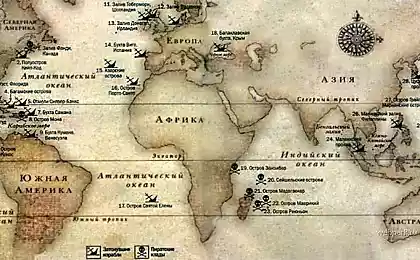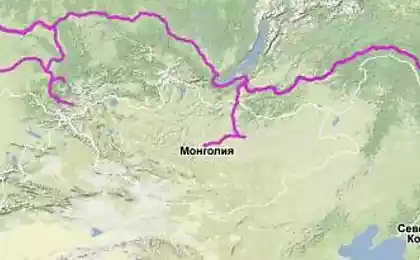996
The search for "alien worlds" most interesting
According to the statistical analysis, in our galaxy may be, on average, one planet to the star (!). This means that in a radius of 50 light years from Earth may be up to a thousand a variety of planets (!!).
The research team led by Stephen Kane (Stephen Kane) from the Institute for the Study of exoplanets California Institute of Technology is based on the 6-year study of the program PLANET using the microlensing technique. The method is as follows. One closer to the star, we can serve as a magnifying glass to the background stars, increasing its brightness at times, and sometimes this phenomenon leads to an additional illumination of the planets belonging to that distant system. The method is very similar to the method of gravitational lenses, which is now widely used in cosmology.
post contains a bit of humor =)

Yes, well, we continue. It is estimated that Earth-like planets should be much larger than the planets such as Jupiter, and a rough calculation based on this assumption gives the amount of up to 10 billion. Earth-like planets in the galaxy (!!!)
"The results of all three of the existing methods for the discovery of exoplanets, including microlenses, agree that the planet is not only widespread in the galaxy, the small planets should be much more than the big ones." Says Stephen Kane & quot; And this is very good news for all hunters planets.
So, at first it seems that nothing new team of Stephen did not. Intuitively, the time of the Kepler space found more than 2 thousands of candidates for extrasolar planets, and MBT found them a few hundred directly from Earth, with time their number will grow just the same wild pace. Again, it is intuitively clear that the small planet should be more than great. But big is easier to find, we are now open, basically, only them. In principle, it is clear that someone had to do stat.analiz these data.
But the result of this analysis is still staggering. Up to ten billion land in the galaxy !!! Guys, you're still in doubt, are we alone in the universe? In my opinion, the answer to this question is obvious. According to the results of statistical analysis. Now, the most interesting exoplanets known to date.
Not so long ago, it was discovered three planets the size of Mars!
PASADENA, CA - Kepler mission, astronomers announced the discovery of the smallest exoplanets 3. The star KOI-961 were found three planets radius of 0.78, 0.73 and 0.57 Earth radii!
Earth-like planet with a solid surface, which revolve around its star is too close, out of habitability, and the water can not exist on the surface of a liquid. Among the more than 700 open currently exoplanets, Earth-like planets can be counted on the fingers of two (not one) hand.
KOI-961 - a red dwarf with a diameter of one-sixth of the sun, and only 70% more than Jupiter. The planets are too close to its star, making the entire system, according to John Johnson (John Johnson) from Caltech, very tiny planetary system known to us. "Generally speaking, it looks like its size to Jupiter satellites - less than any other planetary system known to us. The discovery provides further proof of the enormous diversity of planetary systems in our galaxy. »
Red dwarfs are very, very common in the galaxy. Thus, the discovery shows that such systems of a number of Earth-like planets from the red dwarf can be a lot.
Figure of these planets: Top KOI-961 with three planets, at the bottom - Jupiter with 4 large satellites

Let's go further.
Former champions among the smallest.
Before KOI-961 it was Kepler 20d and 20f. The photo size comparison. 3rd - Earth.
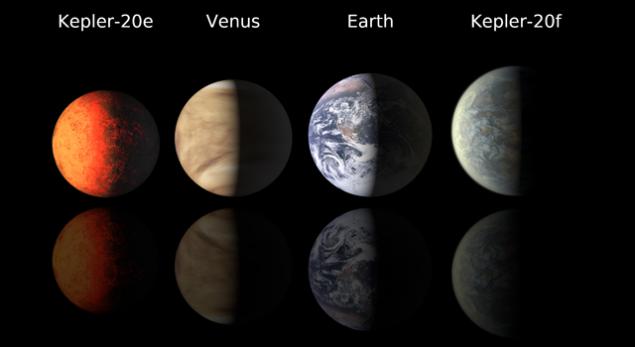
The biggest
The planet, which in theory could not exist, as the theorists say. A practice silently smile and rubbed spectrographs ... Named as TrES-4, the planet is 1.7 times larger than Jupe, and belongs to a small subclass of so-called "fluffy" planet (well, as they are called?) - With exceptionally low density. Tres-4 is located at a distance of 1,400 light-years away and loitering around the star with a period of only 3.5 days.
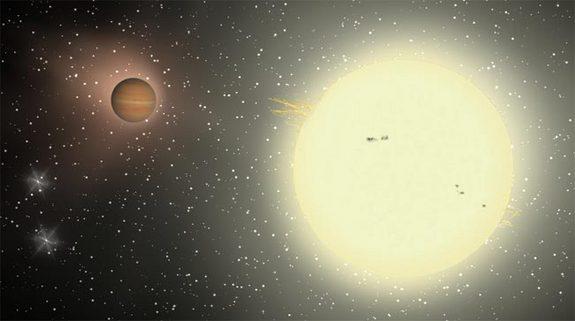
Nearest
Epsilon Eridani has long teased astronomers - the way it is similar to the sun, so that it is close to us, just 10.5 light-years. Now the world is still here and found. However, the planets are too far away, the water there may be just like ice, but you never know ...
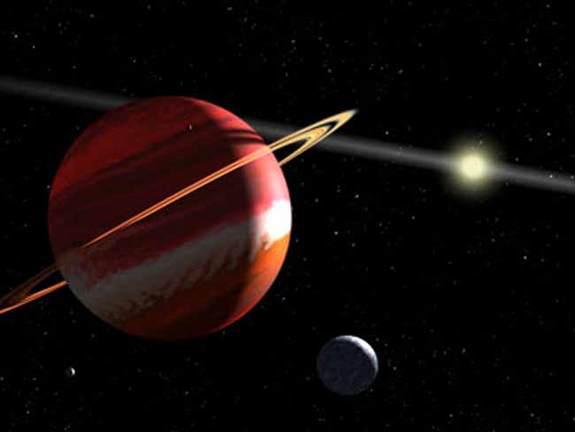
Volcanic nightmare
Planet CoROT-7b - first, for which confirmed the presence of a solid, rocky surface. But there should not rush. In - the first, because of its proximity to its star where the temperature of 2200 degrees Celsius, and secondly, to all appearances, this is just the core of rock vaporized gas giant, in the third tidal forces so torn it apart, it is likely it Not long left.
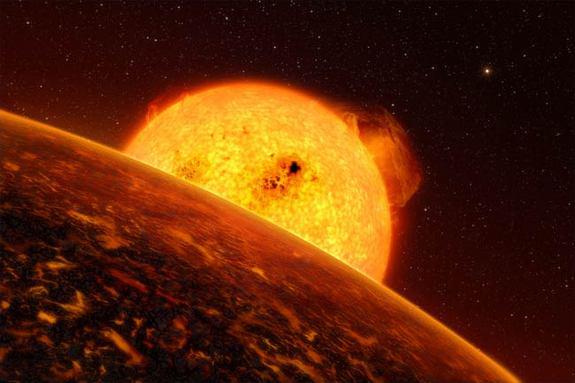
Tatooine
And how else to call a planet in the sky where two suns? It has a weight of one third of the mass of Jupiter, and its diameter - three-quarters of the diameter of Jupiter, making it very similar in size and mass of Saturn - that rings just does not have. Its year lasts 229 Earth days, which is similar to a year on Venus - 225 days. It is quite cold - the temperature in the region of -38 degrees Celsius.
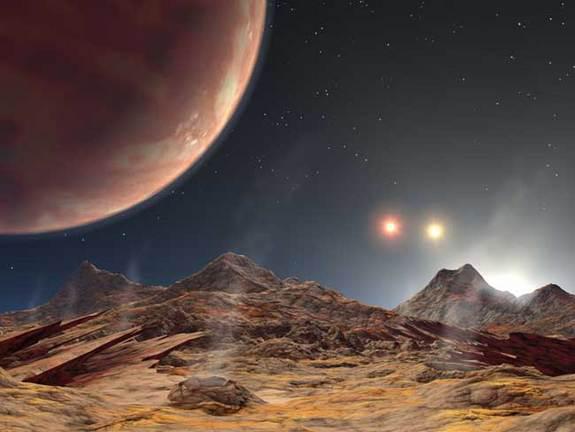
The most distant, coldest
With a surface temperature of -220 Celsius at and away from us at a distance of 28,000 light years, this planet is furious with the name OGLE-2005-BLG-390L on the right is what is written in the subtitle. Unapproachable, cold, distant ... right Snow Queen some ... Its weight - 5.5 Earth masses, but the hostess - a star - a red dwarf.

The hottest, most carbon
WASP-12b is dancing to the rhythm of salsa ... closer to the rest of its star, it is red-hot to a temperature of 2200 Celsius, and a full circle on the dance floor (Well, that is a star) She writes for 1 Earth day. The gaseous planet and a half times heavier than Jupe and almost 2 times greater than its diameter. Is this a ball of fire at a distance of 870 light years from this planet nas.A still unusually rich in carbon. We can say, diamonds are just sprinkled on the surface! Other studies suggest that the star is gradually destroying the planet and live it a little left,

Moss-covered ancient
But deduschka, who was a young man when the sun itself was not in sight. Only 2 billion years after the Big Bang, the universe took to create this planet, whose age now has about 12.7 (!) Billion years! The discovery of this planet in our beloved globular cluster M4 prompted scientists to think - what if the formation of planets in the universe began much earlier than expected? What if these planetary systems is much, much more than we thought?
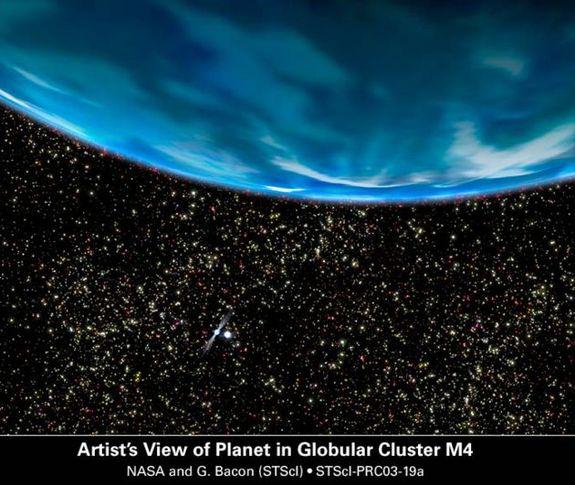
The youngest
She is only 1 million years old, and she turns around a star Coku Tau / 4 (in Russian - T Tauri), at a distance of 420 light-years away. Studying dust disk stars, astronomers have suddenly found it a huge hole - 10 astronomical units. Who cleaned out all the dust from the disk? Well, of course the planet! Here's a young scavenger-shiner in the constellation Taurus showed ...

Most fluffy
White and fluffy HAT-P-1 a density less than the density of cork, Jupiter-mass but at 1.76 times its size, can literally float in water. If you are, of course he will choose the appropriate size pool ...

Tilted world
Normally, the orbital plane of the planets coincides with the equatorial plane of their stars. But this exotic flies in an orbit inclined at 37 degrees. XO-3b is similar in this respect to Pluto, whose orbit is also tilted to the plane of the solar system.
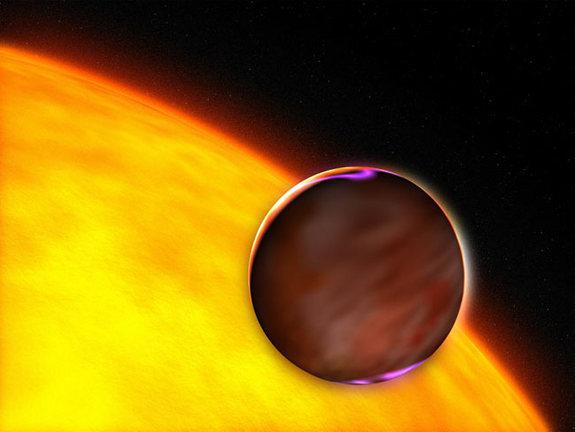
Fastest
SWEEPS-10 - a real sprinter. By force of circumstances it is at a distance of about a million kilometers from the star, and to keep from falling on her, rushes with a wild speed, making a turnover of 1 Earth Day. Planet has forced scientists to add another subclass of its conduits and call him - a planet with an ultrashort period, ie those with a year of only 1 day ... It is interesting to reflect how changes there are times of the year - for example, morning - spring day - summer evening - autumn night - Winter ...

Waterworld
Yes, there already is. GJ 1214b- rocky planet with water on the surface, at a distance of 40 light years. The first super-Earths - heavier than Earth and easier to Neptune, which confirmed the presence of an atmosphere. And here it is assumed that there is not only the atmosphere, and that the entire planet may be covered by the ocean ... Investigations are continuing, Kevin Costner already know.
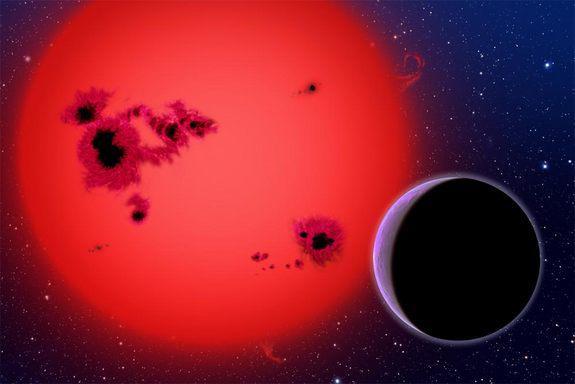
Doomed Planet
WASP-18b, we will remember this. It is possible that we will see it at the last moment of her life. The fact that some elements of its orbit indicate that it gradually spirally reduced and will soon be crashing into a star.

Potentially habitable
Gliese 581 has been very rich and interesting planetary system. One of its planets, d, only 8 times heavier than the Earth, but more importantly, it is in the comfort zone to the limit - habitable zone of its star - a red dwarf. The whole system is located at a distance of 20.5 light-years away and is a very comfortable and rewarding subject for researchers.
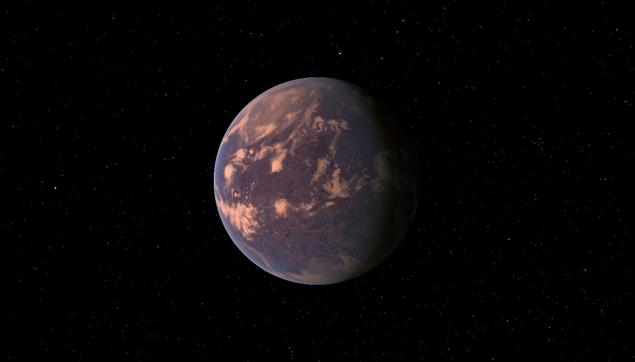
Thick burly
CoROT-exo-3b - one of the densest planets known to us. It Jupe size, but 20 times more massive 2 times denser than lead. Rather, it is a failed star or a brown dwarf.
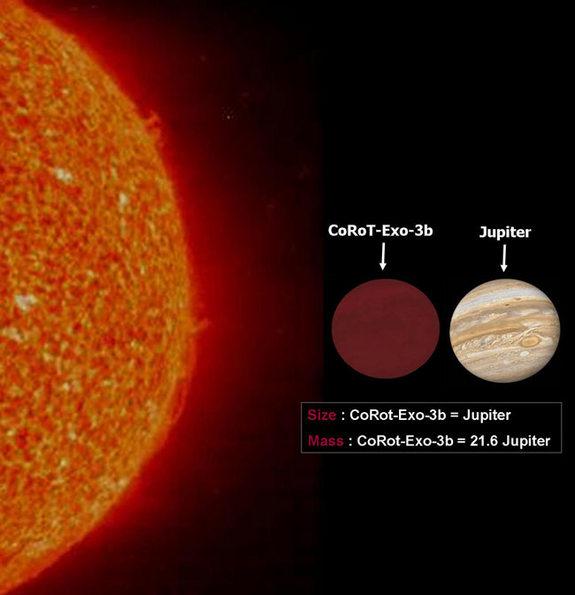
Of rough diamond
And it is such an exotic, it's hard to imagine something more exotic ... There was a dual system, where one of the partners has blown up, its core has shrunk, and the second, the pulsar PSR J1719-1438 so still "doge" is a carbon core, it was ... Diamond planet (!). The whole system is so tiny, it can fit inside our Sun ...
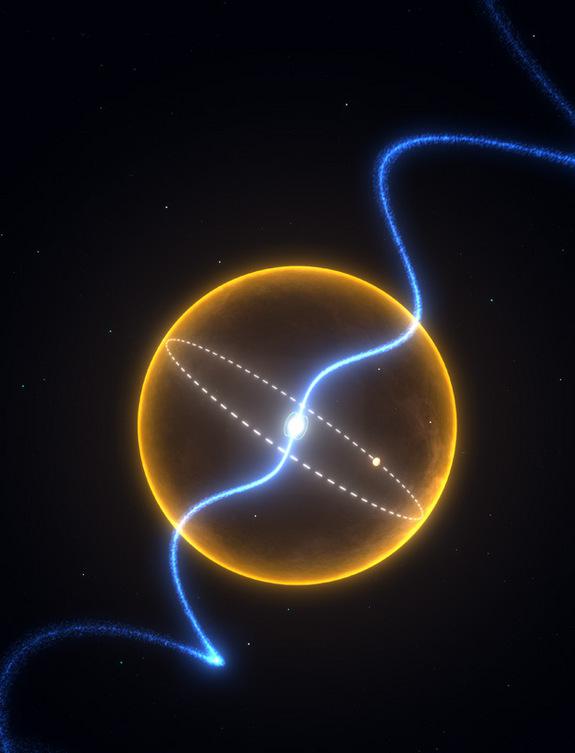
Dark Planet
The darkest known planets TrES-2b with the albedo (reflectivity) of black coal. The size of Jupiter, it represents only 1% of the incident light - Black all that we know in the solar system ...

The world is falling apart
The star of this system, called CoRoT-2a, with their strong X-rays are literally destroying the planet, which is at a very close orbit. These rays are a hundred thousand times stronger than those who received the Earth from the Sun, and they bring serious damage to the planet. Astronomers estimate that the radiation of high-energy literally vaporizes up to 5 million tons of matter every second from the surface of the planet.
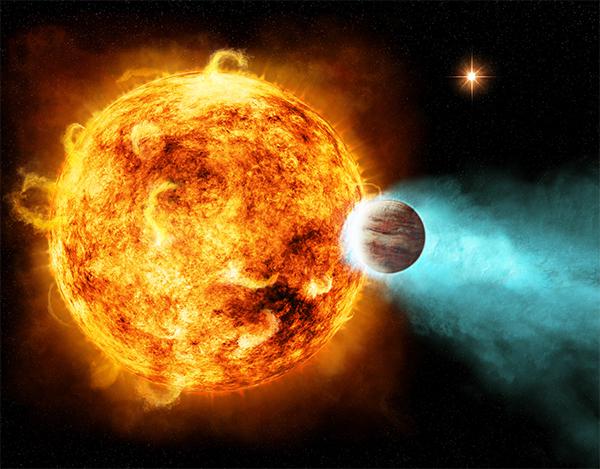
Strendzherz Ze Ying Ku
The two planets - orbit the giant close pair of two stars - white dwarfs and red! The whole fraternity is in the constellation of the furnace. Gravity constantly pulls off a white dwarf material on the surface of red in a continuous stream. This thread cuts into a white dwarf, is heated to extremely high temperatures, emitting a huge amount of deadly X-rays.

Planet - orphans
Lonely, restless planet wandering in the darkness of the galaxy ... without its star, thrown out of someone's system, they are extremely difficult to detect, but they should be very, very much in our galaxy.
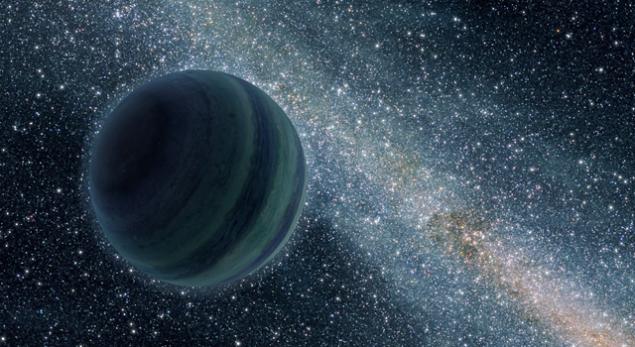
The hunt for exoplanets.
The first planets were detected in 1992, the pulsar, as it may seem, at a distance of a thousand light-years from Earth and even on top just two. Discover the planet from main sequence stars were able to 1995m.
But while the technology was insufficiently mature methods for the detection of planets around distant suns remained in its infancy, and the search was like art - a complex, contradictory, poorly reproducible.
By the mid-2000s, techniques and technologies has finally reached a certain level, and the results have started to appear in dozens.
In November 2010, it was aware of the 500 planets, and just two months this number has exceeded 600 after the European Southern Observatory announced the simultaneous opening of 50 new exoplanets, one of which turned out to be super-Earths in the habitable zone of its star with a good chance of being there life in some form.
But the pace of research and the results are just beginning to accelerate. Work only a single tool can double this amount. Since the launch of the Kepler telescope, he found one and a half thousand candidates for extrasolar planets. And the number is still to grow.
In this scheme, all the 1250 candidates for extrasolar planets discovered by Kepler satellite.

Variety.
By themselves, the numbers certainly are impressive. But it is not in them, and in the diversity of their properties, which is simply amazing. Is there a planet denser than iron, and have air like cotton candy.
There are a class of hot Jupiters - large planets orbiting so close to its star that they are heated to the melting point of iron.
Any planet that ruthless star - giant simply vaporizes his hard X-rays.
There are systems of 5 or more planets in circular orbits.
But the most delicious - something for which all this, and factory - opening extrasolar planets similar to Earth in the habitable zone of its star, where water could be liquid. And then, even after some time, when she's ready methodology and tools ever on one of the selected candidates for extrasolar planets will be found signatures of life - the first extraterrestrial, alien life.
Is there still a discovery in the history of mankind, which would be of great value?
This handsome catalog of the Kepler space telescope
That's all. Information taken from the site

Source:
The research team led by Stephen Kane (Stephen Kane) from the Institute for the Study of exoplanets California Institute of Technology is based on the 6-year study of the program PLANET using the microlensing technique. The method is as follows. One closer to the star, we can serve as a magnifying glass to the background stars, increasing its brightness at times, and sometimes this phenomenon leads to an additional illumination of the planets belonging to that distant system. The method is very similar to the method of gravitational lenses, which is now widely used in cosmology.
post contains a bit of humor =)

Yes, well, we continue. It is estimated that Earth-like planets should be much larger than the planets such as Jupiter, and a rough calculation based on this assumption gives the amount of up to 10 billion. Earth-like planets in the galaxy (!!!)
"The results of all three of the existing methods for the discovery of exoplanets, including microlenses, agree that the planet is not only widespread in the galaxy, the small planets should be much more than the big ones." Says Stephen Kane & quot; And this is very good news for all hunters planets.
So, at first it seems that nothing new team of Stephen did not. Intuitively, the time of the Kepler space found more than 2 thousands of candidates for extrasolar planets, and MBT found them a few hundred directly from Earth, with time their number will grow just the same wild pace. Again, it is intuitively clear that the small planet should be more than great. But big is easier to find, we are now open, basically, only them. In principle, it is clear that someone had to do stat.analiz these data.
But the result of this analysis is still staggering. Up to ten billion land in the galaxy !!! Guys, you're still in doubt, are we alone in the universe? In my opinion, the answer to this question is obvious. According to the results of statistical analysis. Now, the most interesting exoplanets known to date.
Not so long ago, it was discovered three planets the size of Mars!
PASADENA, CA - Kepler mission, astronomers announced the discovery of the smallest exoplanets 3. The star KOI-961 were found three planets radius of 0.78, 0.73 and 0.57 Earth radii!
Earth-like planet with a solid surface, which revolve around its star is too close, out of habitability, and the water can not exist on the surface of a liquid. Among the more than 700 open currently exoplanets, Earth-like planets can be counted on the fingers of two (not one) hand.
KOI-961 - a red dwarf with a diameter of one-sixth of the sun, and only 70% more than Jupiter. The planets are too close to its star, making the entire system, according to John Johnson (John Johnson) from Caltech, very tiny planetary system known to us. "Generally speaking, it looks like its size to Jupiter satellites - less than any other planetary system known to us. The discovery provides further proof of the enormous diversity of planetary systems in our galaxy. »
Red dwarfs are very, very common in the galaxy. Thus, the discovery shows that such systems of a number of Earth-like planets from the red dwarf can be a lot.
Figure of these planets: Top KOI-961 with three planets, at the bottom - Jupiter with 4 large satellites

Let's go further.
Former champions among the smallest.
Before KOI-961 it was Kepler 20d and 20f. The photo size comparison. 3rd - Earth.

The biggest
The planet, which in theory could not exist, as the theorists say. A practice silently smile and rubbed spectrographs ... Named as TrES-4, the planet is 1.7 times larger than Jupe, and belongs to a small subclass of so-called "fluffy" planet (well, as they are called?) - With exceptionally low density. Tres-4 is located at a distance of 1,400 light-years away and loitering around the star with a period of only 3.5 days.

Nearest
Epsilon Eridani has long teased astronomers - the way it is similar to the sun, so that it is close to us, just 10.5 light-years. Now the world is still here and found. However, the planets are too far away, the water there may be just like ice, but you never know ...

Volcanic nightmare
Planet CoROT-7b - first, for which confirmed the presence of a solid, rocky surface. But there should not rush. In - the first, because of its proximity to its star where the temperature of 2200 degrees Celsius, and secondly, to all appearances, this is just the core of rock vaporized gas giant, in the third tidal forces so torn it apart, it is likely it Not long left.

Tatooine
And how else to call a planet in the sky where two suns? It has a weight of one third of the mass of Jupiter, and its diameter - three-quarters of the diameter of Jupiter, making it very similar in size and mass of Saturn - that rings just does not have. Its year lasts 229 Earth days, which is similar to a year on Venus - 225 days. It is quite cold - the temperature in the region of -38 degrees Celsius.

The most distant, coldest
With a surface temperature of -220 Celsius at and away from us at a distance of 28,000 light years, this planet is furious with the name OGLE-2005-BLG-390L on the right is what is written in the subtitle. Unapproachable, cold, distant ... right Snow Queen some ... Its weight - 5.5 Earth masses, but the hostess - a star - a red dwarf.

The hottest, most carbon
WASP-12b is dancing to the rhythm of salsa ... closer to the rest of its star, it is red-hot to a temperature of 2200 Celsius, and a full circle on the dance floor (Well, that is a star) She writes for 1 Earth day. The gaseous planet and a half times heavier than Jupe and almost 2 times greater than its diameter. Is this a ball of fire at a distance of 870 light years from this planet nas.A still unusually rich in carbon. We can say, diamonds are just sprinkled on the surface! Other studies suggest that the star is gradually destroying the planet and live it a little left,

Moss-covered ancient
But deduschka, who was a young man when the sun itself was not in sight. Only 2 billion years after the Big Bang, the universe took to create this planet, whose age now has about 12.7 (!) Billion years! The discovery of this planet in our beloved globular cluster M4 prompted scientists to think - what if the formation of planets in the universe began much earlier than expected? What if these planetary systems is much, much more than we thought?

The youngest
She is only 1 million years old, and she turns around a star Coku Tau / 4 (in Russian - T Tauri), at a distance of 420 light-years away. Studying dust disk stars, astronomers have suddenly found it a huge hole - 10 astronomical units. Who cleaned out all the dust from the disk? Well, of course the planet! Here's a young scavenger-shiner in the constellation Taurus showed ...

Most fluffy
White and fluffy HAT-P-1 a density less than the density of cork, Jupiter-mass but at 1.76 times its size, can literally float in water. If you are, of course he will choose the appropriate size pool ...

Tilted world
Normally, the orbital plane of the planets coincides with the equatorial plane of their stars. But this exotic flies in an orbit inclined at 37 degrees. XO-3b is similar in this respect to Pluto, whose orbit is also tilted to the plane of the solar system.

Fastest
SWEEPS-10 - a real sprinter. By force of circumstances it is at a distance of about a million kilometers from the star, and to keep from falling on her, rushes with a wild speed, making a turnover of 1 Earth Day. Planet has forced scientists to add another subclass of its conduits and call him - a planet with an ultrashort period, ie those with a year of only 1 day ... It is interesting to reflect how changes there are times of the year - for example, morning - spring day - summer evening - autumn night - Winter ...

Waterworld
Yes, there already is. GJ 1214b- rocky planet with water on the surface, at a distance of 40 light years. The first super-Earths - heavier than Earth and easier to Neptune, which confirmed the presence of an atmosphere. And here it is assumed that there is not only the atmosphere, and that the entire planet may be covered by the ocean ... Investigations are continuing, Kevin Costner already know.

Doomed Planet
WASP-18b, we will remember this. It is possible that we will see it at the last moment of her life. The fact that some elements of its orbit indicate that it gradually spirally reduced and will soon be crashing into a star.

Potentially habitable
Gliese 581 has been very rich and interesting planetary system. One of its planets, d, only 8 times heavier than the Earth, but more importantly, it is in the comfort zone to the limit - habitable zone of its star - a red dwarf. The whole system is located at a distance of 20.5 light-years away and is a very comfortable and rewarding subject for researchers.

Thick burly
CoROT-exo-3b - one of the densest planets known to us. It Jupe size, but 20 times more massive 2 times denser than lead. Rather, it is a failed star or a brown dwarf.

Of rough diamond
And it is such an exotic, it's hard to imagine something more exotic ... There was a dual system, where one of the partners has blown up, its core has shrunk, and the second, the pulsar PSR J1719-1438 so still "doge" is a carbon core, it was ... Diamond planet (!). The whole system is so tiny, it can fit inside our Sun ...

Dark Planet
The darkest known planets TrES-2b with the albedo (reflectivity) of black coal. The size of Jupiter, it represents only 1% of the incident light - Black all that we know in the solar system ...

The world is falling apart
The star of this system, called CoRoT-2a, with their strong X-rays are literally destroying the planet, which is at a very close orbit. These rays are a hundred thousand times stronger than those who received the Earth from the Sun, and they bring serious damage to the planet. Astronomers estimate that the radiation of high-energy literally vaporizes up to 5 million tons of matter every second from the surface of the planet.

Strendzherz Ze Ying Ku
The two planets - orbit the giant close pair of two stars - white dwarfs and red! The whole fraternity is in the constellation of the furnace. Gravity constantly pulls off a white dwarf material on the surface of red in a continuous stream. This thread cuts into a white dwarf, is heated to extremely high temperatures, emitting a huge amount of deadly X-rays.

Planet - orphans
Lonely, restless planet wandering in the darkness of the galaxy ... without its star, thrown out of someone's system, they are extremely difficult to detect, but they should be very, very much in our galaxy.

The hunt for exoplanets.
The first planets were detected in 1992, the pulsar, as it may seem, at a distance of a thousand light-years from Earth and even on top just two. Discover the planet from main sequence stars were able to 1995m.
But while the technology was insufficiently mature methods for the detection of planets around distant suns remained in its infancy, and the search was like art - a complex, contradictory, poorly reproducible.
By the mid-2000s, techniques and technologies has finally reached a certain level, and the results have started to appear in dozens.
In November 2010, it was aware of the 500 planets, and just two months this number has exceeded 600 after the European Southern Observatory announced the simultaneous opening of 50 new exoplanets, one of which turned out to be super-Earths in the habitable zone of its star with a good chance of being there life in some form.
But the pace of research and the results are just beginning to accelerate. Work only a single tool can double this amount. Since the launch of the Kepler telescope, he found one and a half thousand candidates for extrasolar planets. And the number is still to grow.
In this scheme, all the 1250 candidates for extrasolar planets discovered by Kepler satellite.

Variety.
By themselves, the numbers certainly are impressive. But it is not in them, and in the diversity of their properties, which is simply amazing. Is there a planet denser than iron, and have air like cotton candy.
There are a class of hot Jupiters - large planets orbiting so close to its star that they are heated to the melting point of iron.
Any planet that ruthless star - giant simply vaporizes his hard X-rays.
There are systems of 5 or more planets in circular orbits.
But the most delicious - something for which all this, and factory - opening extrasolar planets similar to Earth in the habitable zone of its star, where water could be liquid. And then, even after some time, when she's ready methodology and tools ever on one of the selected candidates for extrasolar planets will be found signatures of life - the first extraterrestrial, alien life.
Is there still a discovery in the history of mankind, which would be of great value?
This handsome catalog of the Kepler space telescope
That's all. Information taken from the site

Source:











